

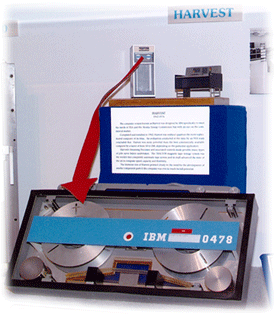 The extraordinary versatility and efficiency of electronic computers
have made them useful in handling almost every class of data. With the
earliest design work on computers in 1946 came the realization of the
potential usefulness of such machines for Agency purposes. NSA's computer
installation ranks among the largest in the country.
The extraordinary versatility and efficiency of electronic computers
have made them useful in handling almost every class of data. With the
earliest design work on computers in 1946 came the realization of the
potential usefulness of such machines for Agency purposes. NSA's computer
installation ranks among the largest in the country.
NSA has been a silent partner with private industry from the earliest days of postwar computer development. Many commercial computer lines have sprouted from earlier designs for NSA use. A good example of this partnership was a cooperative project in the 1950s between NSA and IBM. The result of this collaboration, HARVEST, went on line in 1962 and was finally retired in 1976. IBM built a new, state-of-the-art second-generation general-purpose processor. To be successful, HARVEST had to have a super high-speed memory and high-speed tape drives, beyond anything then in existence. Developed over a five-year period, the most innovative component was TRACTOR, the high-speed tape drive system. It was the first fully automated storage and retrieval system and a precursor to some of today's storage systems, such as StorageTek.
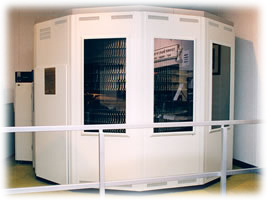 The Storage Technology Corporation produces some of NSA's recording
media storage libraries. This machine is an example of an automated tape
cartridge system. It was designed for large, complex, high-performance
environments, such as NSA's. It has the capacity for 6,000 tape cartridges
each holding 50 gigabytes of data: a total of 300 terabytes. (300 terabytes
would fill enough 8.5x11 paper to circle the globe more than 3,000 times!)
Using a robotic arm, this StorageTek machine is capable of exchanging
175 cartridges per hour.
The Storage Technology Corporation produces some of NSA's recording
media storage libraries. This machine is an example of an automated tape
cartridge system. It was designed for large, complex, high-performance
environments, such as NSA's. It has the capacity for 6,000 tape cartridges
each holding 50 gigabytes of data: a total of 300 terabytes. (300 terabytes
would fill enough 8.5x11 paper to circle the globe more than 3,000 times!)
Using a robotic arm, this StorageTek machine is capable of exchanging
175 cartridges per hour.
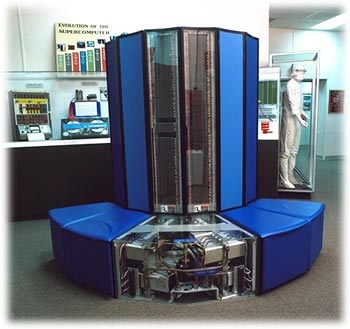 Working
with companies, such as Cray Research Inc., NSA has been a leader in computer
development throughout its history. Some of the earliest supercomputers
were designed and built for the National Security Agency.
Working
with companies, such as Cray Research Inc., NSA has been a leader in computer
development throughout its history. Some of the earliest supercomputers
were designed and built for the National Security Agency.
On exhibit in the museum are two Cray supercomputers. The XMP-24 on display is the upgrade to the original XMP-22 that was the first supercomputer Cray ever delivered to a customer site. It was in operation from 1983 to 1993 and was arguably the most powerful computer in the world when it was delivered. It used serial processing to conduct 420 million operations per second.
The second generation Cray, the YMP, replaced the older version in 1993. It had a 32 gigabyte (32 billion bytes) memory capacity. In 1993 most personal computers held only 16 million bytes. The YMP used vector processing, a very powerful form of overlapping, parallel processing to conduct 2.67 billion operations per second. The YMP was decommissioned and went on display at the museum in 2000.
NSA, with its partners in industry, continues to be a leader in research and development of computer technologies, pioneering the frontiers of computer science and engineering. To house and develop these new systems, NSA has the world's largest supercomputing facility and the Special Processing Lab located on its campus.
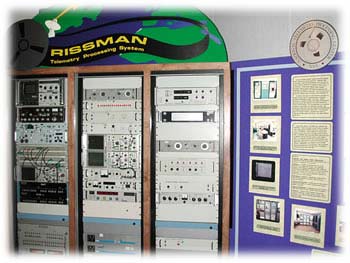 RISSMAN
was a telemetry processing system, built in the early
1980s featuring custom-designed hardware. As part of
NSA's SIGINT mission, telemetry signals were collected
by various platforms. Magnetic tape recordings of the
intercepted signals were then sent to NSA's National
Telemetry Processing Center for processing. These measurements
were then sent on computer tape to various analysis centers
which identified the function of the various transducers
and developed performance estimates. This data was used
to formulate defense policy and guide treaty negotiations.
RISSMAN
was a telemetry processing system, built in the early
1980s featuring custom-designed hardware. As part of
NSA's SIGINT mission, telemetry signals were collected
by various platforms. Magnetic tape recordings of the
intercepted signals were then sent to NSA's National
Telemetry Processing Center for processing. These measurements
were then sent on computer tape to various analysis centers
which identified the function of the various transducers
and developed performance estimates. This data was used
to formulate defense policy and guide treaty negotiations.
TELLMAN, the Agency's first telemetry processor to make extensive use of a general purpose computer, became operational in 1969. In the early 1980's, TELLMAN was replaced with RISSMAN, which processed a wider variety of signals, with higher system reliability and lower maintenance costs. RISSMAN's custom-designed hardware (still required for the front-end of the signal path) is shown in this exhibit. RISSMAN used three Intel 8086 microcomputers to perform real-time process control, while Digital VAX-11 computers provided data demultiplexing, data file storage, user-interface, Local Area Network access, digital tape generation, and quality-control plotting services. RISSMAN was in daily use, often processing tapes around the clock, from the date of its delivery through the end of the Cold War.
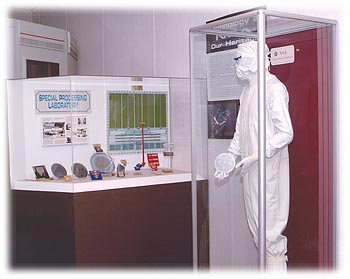 NSA has exacting requirements for special computer chips. Because of
the difficulty of satisfying its needs on the commercial market, and because
of the highly classified nature of some of the chips, NSA opened a facility
in 1991 to fabricate otherwise unobtainable devices. Applications Specific
Integrated Circuits (ASIC) are produced in the Class 10 clean room within
this facility. Microchips are manufactured, not only for NSA's supercomputers,
but also for systems throughout the Department of Defense and the Intelligence
Community.
NSA has exacting requirements for special computer chips. Because of
the difficulty of satisfying its needs on the commercial market, and because
of the highly classified nature of some of the chips, NSA opened a facility
in 1991 to fabricate otherwise unobtainable devices. Applications Specific
Integrated Circuits (ASIC) are produced in the Class 10 clean room within
this facility. Microchips are manufactured, not only for NSA's supercomputers,
but also for systems throughout the Department of Defense and the Intelligence
Community.